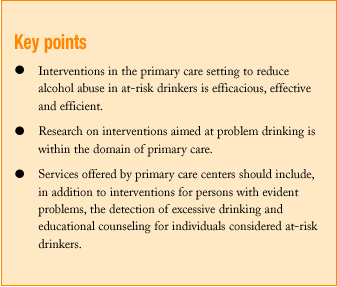Health problems related with the consumption of alcoholic beverages cause alarm because of their health, economic and social consequences. The advisability of preventive interventions at the primary care level has been widely accepted, and such measures have been shown to be effective. The first step is to identify subjects whose consumption is considered to pose a risk: >=28 standard units of alcohol or SUA (1 SUA is 10 mL of pure alcohol) per week in men or >=17 SUA/week in women, or consumption of 5 SUA or more in one drinking session at least once a month). This is followed by educational intervention aimed at helping to reduce intake in drinkers classified as at-risk drinkers, or at achieving abstinence in persons with alcohol dependence.1
The study by Fernández García and colleagues2, like other studies, confirms that interventions provided at the primary care center by family physicians with appropriate skills to perform brief interventions, achieve a 2-year reduction in drinking of 38.9% in patients at risk: 23.8% were abstinent at the end of the follow-up period, and 15% had reduced their alcohol intake. Most subjects were men, and factors with an unfavorable influence on the outcome were age less than 16 years when drinking first started, drinking associated with smoking, and a negative CAGE score.
In 1988 Wallace and colleagues published the first study of the usefulness of counseling provided by general practitioners.3 Since then additional studies have confirmed that the effectiveness of brief counseling to reduce alcohol consumption is about 25%;4 studies published in Spain have reported similar results.5 Most studies have also found that drinking decreased in persons in the control group, who only reported their alcohol intake but did not take part in any other interventions. This suggests that simply inquiring patients about their drinking influences alcohol consumption, which the patient may have previously considered «normal».
Studies published to date have identified some issues, while others require further research. We know that early diagnosis by timely detection, followed by educational intervention, can modify drinking patterns in men. Brief intervention lasting a few minutes, accompanied by educational materials, offers results similar to those obtained with more intensive interventions, and interventions are effective regardless of whether they are provided by physicians or nurses. Some questions that have not received much attention thus far, and which deserve further study, are:
What types of intervention are useful for women, older persons and adolescents?
Are the results related with the number of intervention sessions?
How long do the effects of educational counseling on alcohol consumption last?
In the long term, are follow-up interventions needed to consolidate the lifestyle changes?
What educational support materials provide the best results?
Do educational interventions adapted to the individual´s state of change yield better results?
Should interventions be aimed only at persons who have problems related with drinking, or should interventions be opportunistic, i.e., offered for persons who do not seek medical help for their drinking problem?
These and other questions can only be answered if research continues in this area, which is well within the scope of primary care. We cannot assume that specialists in other levels of care will take it upon themselves to answer questions that are within the domain of the primary care setting. Persons with alcohol-related problems who are seen in specialized care units have a different profile from that of patients seen in primary care, as occurs with other types of problem. Thus research on the effectiveness interventions provided by the family physician is the responsibility of primary care professionals.
Although the results obtained with interventions for at-risk drinking were better than those with other interventions used more widely in primary care, such interventions do not form part of the services regularly offered by primary care centers. The lack of such treatments has been documented in audits of the activities included in the objectives of primary care teams, and their absence raises a new set of questions:
What factors are responsible for the scarcity of preventive activities in primary care facilities related to alcohol abuse?
Which instruments that detect at-risk drinking perform best or are accepted best by patients?
What factors make it easier for health care professionals to extend the range of services they provide?
Is the intervention efficient in economic terms?6
In practice, health care professionals encounter obstacles to detecting problems and modifying unhealthy lifestyles. Some problems are related with the available infrastructure (time, specialized units, training), others are related with uncertainties surrounding the effectiveness of health interventions that can be offered in primary care.7 The patient load, inadequate training or insufficient coordination with specialized services are the most obvious barriers to a more active role for primary care practitioners, family physicians and nursing staff in this serious public health problem. Also lacking is open, public debate on the benefits and risks of drinking (a debate not removed from the concerns of health professionals), and this may well be hindering the formulation of clear proposals. On one hand, legislative measures have been proposed to promote wine-drinking, but on the other hand are the death toll from traffic accidents caused by excess drinking on weekends, and the large number of potential years of life lost.
In closing, I offer some considerations of the consequences of including, within the services provided by the Spanish primary care system, interventions aimed problem drinking. In Spain the number of at-risk drinkers is estimated to be approximately four million, and of these, different studies have found that 25% could reduce their risk if primary care professionals were alert to alcohol abuse in their patients and offered brief interventions. In other words, one million persons stand to benefit annually.









